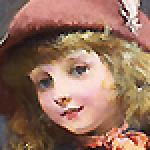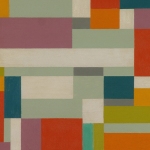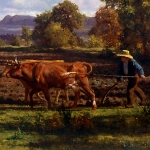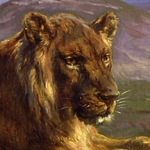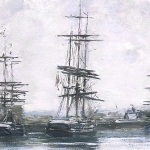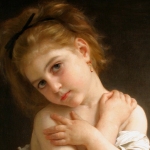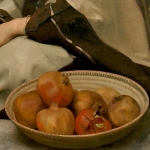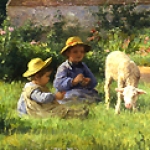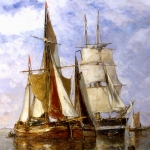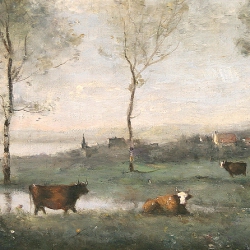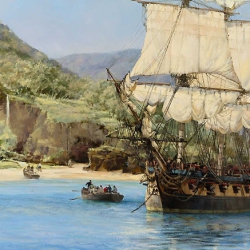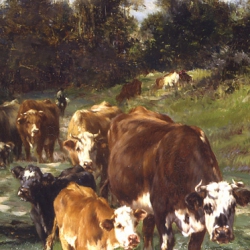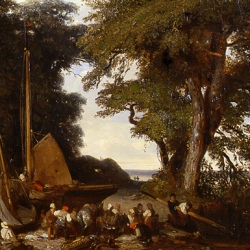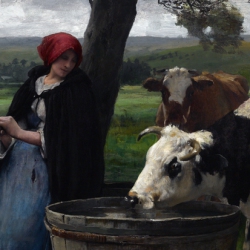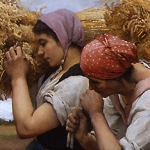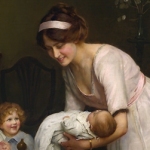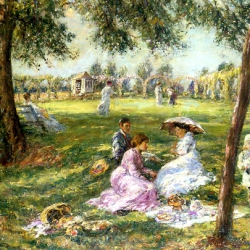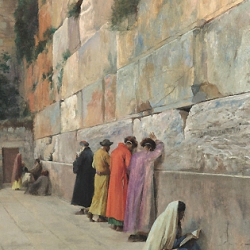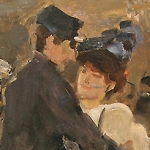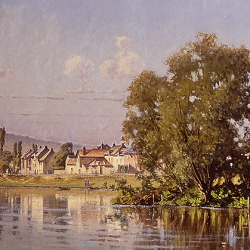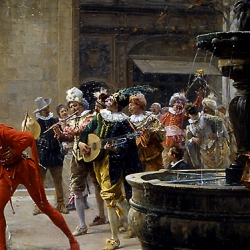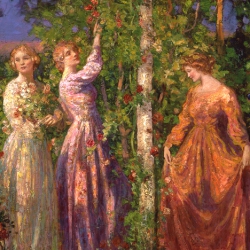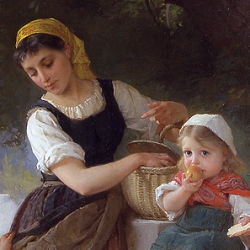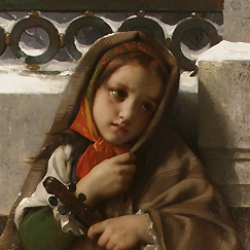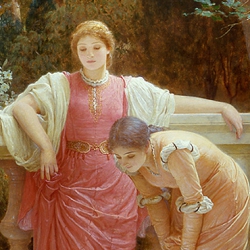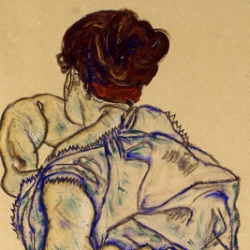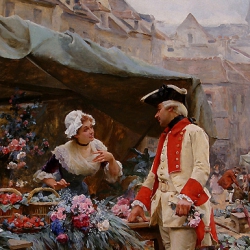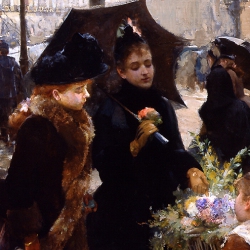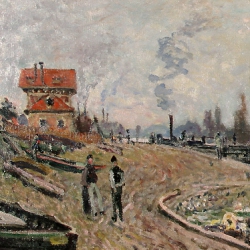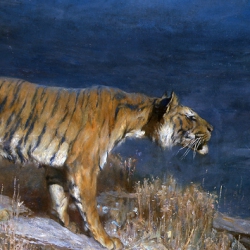|
Dancing at the Moulin de la Galette
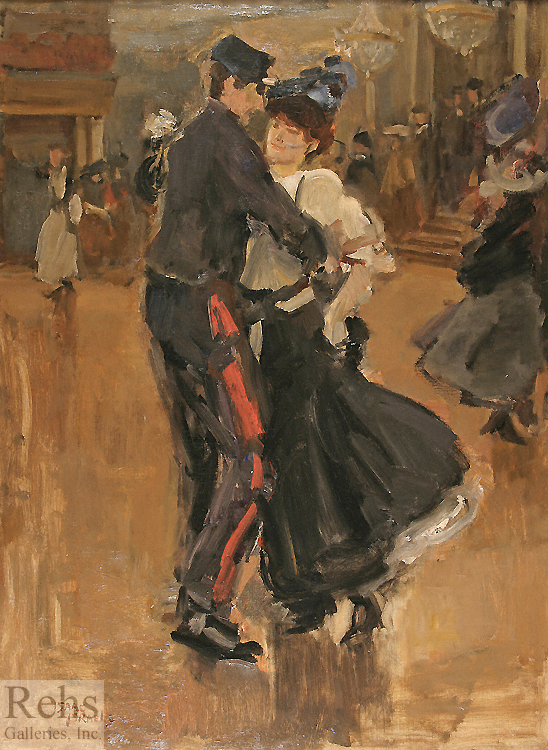 ISAAC ISRAELS
(1865 - 1934)
Dancing at the Moulin de la Galette
Oil on canvas
29 x 21 1/4 inches
Signed
Provenance:
Kunsthandel M.L. de Boer, Amsterdam, titled Danspaar As the only son of the much beloved Dutch genre painter, Joseph Israels, the young Isaac Israels faced the singular task of defining his own artistic style under the tutelage of his distinguished father. Born in Amsterdam on 3 February 1865, the boy showed artistic promise very early, prompting his father to comment in a letter to his friend, John Forbes White: “My Isaac is so fond of animals that he speaks and dreams of them; he is a clever animal painter.” [i] Isaac was six years old at the time. Naturally, Joseph began to teach his son to draw immediately.
In 1871, when Isaac was six, the family moved to The Hague where Joseph developed his growing international reputation as a genre painter. He had already won a third class medal at the Paris Exposition in 1867, as well as the cross of the Legion of Honor from the French Academy. This type of recognition assured the family of a comfortable life, and a steady, often generous, income. The Israels’ home was a lively environment, filled with writers, musicians, art dealers and collectors as well as the artists of The Hague School, and occasional guests such as Edouard Manet and Max Liebermann.
Isaac Israels’ art education began in earnest in 1878 with a family visit to Paris, (which would become an annual event) and with his enrollment at the Academy of The Hague. There, he would not only deepen his skills, but he would also meet George Hendrik Breitner, who became a longtime friend and colleague. Israels’ work from this period displays a technical ability well beyond his years, as well as psychological depth in two 1881 portraits, one of his grandmother Mrs. Schaap, and another of a family friend, Mrs. Nannette Enthoven. What intrigued young Israels even more were the military maneuvers that he witnessed around him. He captured these scenes on two canvases, Barracks Meal and Bugle Practice, which were shown at the Academy’s annual exhibition. In fact, Bugle Practice was so engaging that the collector H. W. Mesdag purchased it immediately.
A year later, in 1882, Israels made his debut at the Salon des Artistes Français in Paris with Military Burial, a precisely composed image of soldiers gathered around an open grave on a dull autumn day. Although comparisons with Gustave Courbet’s Burial at Ornans are inevitable because of the exaggerated rectangular format and the open grave in the foreground, Israels utilized a far more academic composition—a carefully orchestrated circle of soldiers around the grave that has roots in both Italian renaissance and ancient Roman imagery. Nonetheless, the casual stances of the soldiers and the careful articulation of the unforgiving clods of earth speak of Israels’ awareness of naturalist painters such as Jules Bastien-Lepage or Léon Lhermitte. After this successful debut, Israels triumphed again at the 1885 Salon with an honorable mention for Volunteers Departing for the Colonies, another naturalistic military scene, this time set on the docks of Rotterdam. Influential art critic Albert Wolff was so impressed by this work that he wrote: “This young man who has taken such a definitive place in the Salon of 1885 is Monsieur Israels, son of the illustrious Dutch painter. This young man’s painting is one of those rare canvases that force you to stop and think. And that is the highest praise that I can offer.” [ii]
Israels’ accomplishments at the Paris Salon seem to have fueled his desire to investigate more experimental forms of painting. At age twenty, he was eager to absorb new ideas associated with Impressionism and naturalism, particularly the concerns expressed in Emile Zola’s writing about working people; Germinal, one of Zola’s popular novels, was serialized in the newspaper Gil Blas between November 1884 and February 1885, and then published in 1885 just at the moment when young Israels would have arrived in Paris for the opening of the Salon. After his professional triumph, he followed the example of van Gogh, and spent a year traveling through the Belgian mining districts and studying the life of laboring men and women. His art emerged with a stronger sense of color and a fierce commitment to the depiction of modern life. In addition, he applied to the Amsterdam Academy of Art along with his old friend, George Hendrik Breitner.
By 1887 Israels and Breitner were both in Amsterdam, having quickly abandoned the Academy there for the more progressive art circle of the Tachtigers [Eighties Movement]. This avant-garde group consisted of writers and artists who embraced the concept that aesthetic style must reflect the content of a work—and that emotionally charged subjects could only be expressed by equally bold stylistic techniques or language. Not surprisingly, the Tachtigers greatly admired the work of naturalist writers and painters. In response to this influence, Israels shifted his subject matter to the life of Amsterdam’s streets, cafes, and cabarets, focusing on the lives of working people with a ferocious intensity. Although he exhibited very little during these years, Israels explored a wide variety of media, and produced a significant volume of sketches, watercolors, pastels and oil paintings. As he noted in an 1888 letter: “Every morning I get up determined to conquer, every night I give up vanquished.”[iii]
Like their counterparts in Paris or London in the late 1880s and early 1890s, Israels and his friends found urban living exhilarating. They frequented the dance halls and cabarets, soaking up the ever-changing vistas of people jostling through the streets and along the canals. Israels and his friend Frans Erens, a writer, were often seen in the harbor cafes around the Zeedijk [sea dike], an area best known as a Chinese immigrant neighborhood and subsequently, as the renowned red light district of Amsterdam. During these years, Israels also continued to make regular trips to Paris where, in 1889, he met his literary idol, Zola, as well as Stéphane Mallarmé, and the painters, Berthe Morisot and Odilon Redon. Likewise, there were frequent visitors from Paris in Amsterdam, including Paul Verlaine, who stayed with Israels’ friend Willem Witsen while he presented a lecture series in 1892; and apparently thoroughly enjoyed socializing with the Tachtigers circle.
Throughout this lively period, Israels increasingly matched the content of his subjects—working men and women going about their daily tasks—with a style that incorporated bold brushwork and solid forms. Although it has become a commonplace to describe him as an Impressionist, Israels’ work is more akin to that of Paul Cézanne with its emphasis on thickly brushed blocks of color and carefully constructed spatial organization. A painting like Two Girls on the Lijnbaansgracht, for example, is built by applying thick paint with the flat side of the brush; this is not an essay in light and color, but an attempt to anchor the figures firmly in their own urban context.
The year 1893 marked the advent of Israels’ aesthetic maturity. Although it began with the sad news of his mother’s death on January 16, it was also a period when he clearly defined his own artistic vocabulary. His enthusiasm for painting modern life—and his mastery of his own style—can be seen clearly in a series of paintings of female factory workers along the Prinsengracht; here are strongly delineated women positioned against the backdrop of Amsterdam’s characteristic canals and the flat cloudy skies of Holland. Israels’ fascination with recording the daily activities of women even led him to rent a room opposite the Mars millinery shop on Kalverstraat so that he could accurately express the energy of the brightly lit store filled with gloriously decorated hats. A few years later in 1900, Frans Erens remembered Israels’ routine at this time as full of zest: “When dusk falls, he goes into the city and will stroll down Kalverstraat, proud and self-confident, as if watching his own models sauntering along.” [iv]
In May of 1893, Israels and Erens joined Joseph Israels on a trip to Spain and North Africa; although not documented, it seems likely that this trip was, in part, an opportunity for father and son to acknowledge their shared grief over the death of Aleida Israels, and to reconnect as professional colleagues in a fresh context. As was the case for so many European painters, the bright sun and startling colors, textures and patterns of North Africa provided Israels with inspiration for years to come. When he returned to Amsterdam, he began the first of his plein air paintings, Three Servant Girls, in October 1893. Again he attempted to seize the essence of women at work, this time as they dash along the canals to carry out their duties. The solidity of his earlier factory workers is replaced with a brighter color palette and a new focus on the dappled effects of light in his watercolors and pastels; his oil paintings will also incorporate more emphasis on the play of light, but retain the attention to form that he developed earlier in the decade.
As the nineteenth century evolved into the twentieth, Israels launched a new phase of his career by painting at the Amsterdam fashion house of Hirsch—in the showrooms, fitting rooms and workrooms where seamstresses toil at fine needlework under dim lights. Thérèse Schwartze, a childhood friend who was also a painter, introduced Israels to the proprietor of Hirsch, and encouraged him to paint there. This discovery of the world of haute couture would lead to yet another major theme in Israels’ work; the intersection of wealthy buyers, shop girls, models, and hard-working seamstresses offered an irresistible chance to show the disparity among the classes.
The next step was a visit to Paris in 1903, and a subsequent move there in 1904. Once settled at boulevard de Clichy no. 9/rue Alfred Stevens no. 10, adjacent to Montmartre, Israels approached the famous fashion houses on the Place Vendôme and Champs Elysées; he would paint there regularly until the outbreak of World War I. Israels was particularly fond of the House of Pacquin, founded in 1891 by Jeanne Pacquin, the first woman to own her own fashion house. In spite of his association with such elegantly designed clothing—and the women who purchased it—Israels’ primary interest was in the seamstresses and models that toiled to create these illusions of sophistication. Over and over, these paintings underscore the dimly lit workrooms where women plied their skilled needles on yards and yards of luscious fabric. These are not glamorous images of high fashion, but stubbornly naturalistic depictions of the reality underlying its creation.
At forty years old, Israels enjoyed his life in Paris. He had steady sales and a circle of friends that included his countryman Kees von Dongen and the Fauves painters, as well as Théophile Steinlen, another denizen of Montmartre. Paintings of women at work continue to be a source of fascination for Israels, but his images from these years also encompass a wealth of scenes from cafes, bars and the local dancehalls; the Moulin de la Galette, located on the top of the hill in Montmartre, was a particular favorite. Dancing and flirting couples are a staple of this work as well as an unusual series of women seated alone in cafes and restaurants. Likewise, Israels highlights the nightlife of Montmartre in paintings of carousels, acrobats from the Cirque Medrano, and singers from café-concerts such as La Feria.
The decade in Paris between 1903-1913 ended abruptly as Europe stumbled blindly into a cataclysmic war. Israels spent 1913-14 in London, again painting the dynamic life of the city; by the spring of 1915, he was in Berne, Switzerland hoping to get back to Paris, a wish that would not be fulfilled until the end of the war. Instead, he returned to the nominally neutral Holland, tending to family affairs in The Hague and then settling in Amsterdam for the duration of the war. For the most part, Israels worked as a portrait painter during this period. One of his most famous sitters was Magaretha Gertrud Zelle, better known as Mata Hari, whose 1916 portrait illustrates a striking Dutch woman dressed head-to-toe in a black, fur-trimmed coat and hat. More intriguing is the series of portraits of Dutch women posed in front of van Gogh’s famous Sunflowers from the late 1880s. Dating from 1917, these portraits range from a very proper matron in a designer gown seated on a bench in front of the van Gogh to a bare-breasted young woman posing in profile before the Sunflowers. Presumably Israels’ copy of van Gogh’s masterpiece was one of the more popular studio backdrops for his Dutch clients.
Following the war, the peripatetic Israels makes up for lost time with visits to Paris, Copenhagen, Stockholm and London; and in October 1921, he departs for the Dutch East Indies. Traveling through parts of India, Bali and Java, he sketches the vibrant life of south Asia in a numerous fluid watercolors, images that eventually emerge as oil paintings in 1922. The Gamelan Players is particularly remarkable for its contrast between the serenity of the seated musicians and the sparkling light that seems to visually punctuate the rhythms of the implicit music.
Upon his return from the Dutch East Indies, Israels returned to The Hague, giving up his apartment in Paris for good, but continuing to travel regularly to London, Italy and the French Riviera. His work from this period includes many portraits as well as a series of paintings based on scenes from the Scala Theatre, a vaudeville-style stage in The Hague. Just as in his paintings of fashion houses or dance halls in Paris, Israels remains most interested in the lives of ordinary—or even marginal—people as they go about their routine jobs.
The 1930s brought economic anxiety to Holland as well as everywhere else, but Israels’ only concession to this new reality seems to have been a series of lithographs for the art dealer, G. H. Nieuwehuizen Segaar in 1931. This relatively affordable form of art provided an extra financial cushion for his still reliable portrait painting. In addition, Israels continued to exhibit his work at local galleries. On 4 October 1934, he attended one such show of his drawings at H. E. d’Audretsch’s art gallery, but was hit by a car near his home that evening. Although his injuries did not initially seem life threatening, Isaac Israels died three days later on 7 October 1934 at age sixty-nine.
Janet Whitmore, Ph.D.
Museums (All locations in The Netherlands unless otherwise noted.)
Caldic Collection, Rotterdam Centraal Museum, Utrecht Dordrecht Museum, Dordrecht Frans Halsmuseum, Haarlem Gemeentemuseum, The Hague Groninger Museum, Groningen Hannema-de Stuers Foundation, Heino Historisch Museum Het Schielandshuis, Rotterdam Koninklijk Instituut voor de Tropen, Amsterdam Museum Boyjmans-Van Beuningen, Rotterdam Museum der bildenden Künste, Leipzig, Germany Museum Folkwang, Essen, Germany Museum Kröller-Muller, Otterlo Museum Mesdag, The Hague Museum voor Moderne Kunst, Arnhem Rijksmuseum, Amsterdam Stedlijk Museum, Schiedam Teylers Museum, Haarlem Universiteitsmuseum De Agnietenkapel, Universiteit van Amsterdam Van Abbemuseum, Eindhoven Van Gogh Museum, Amsterdam
[i] Letter from Joseph Israels to John Forbes White; see Ina Mary Harrower “Jozef Israels and his Aberdeen Friend” Aberdeen University Review XIV, 1927, 113.
[ii] Albert Wolff, Le Figaro, June 1885. [Le jeune homme, qui prend définitivement rang au Salon de 1885 est M. Israels, fils de l’illustre peintre holandais…Le tableau de ce jeune homme est une des rare toiles, qui vous arrêtent et vous font réfléchir. C’est le meilleur élogue que j’en puisse faire.”]
[iii] Anna Wagner, Isaac Israels, Translated from the Dutch by E. H. B. van Noorden Cowan, (Amsterdam: Meulenhoff, 1969), 9. From Isaac Israels’ letter of June 20 1888, originally published in Kunstenaarsbrieven, Wereldbibliotheek, Amsterdam, 1937, 53.
[iv] Anna Wagner, Isaac Israels, Translated from the Dutch by E. H. B. van Noorden Cowan, (Amsterdam: Meulenhoff, 1969), 9-10. Originally published in Frans Erens, “Isaac Israels”, Elsevier’s Geillustreerd Maandschrift XX, 1900, 10. |
|
|||||||


